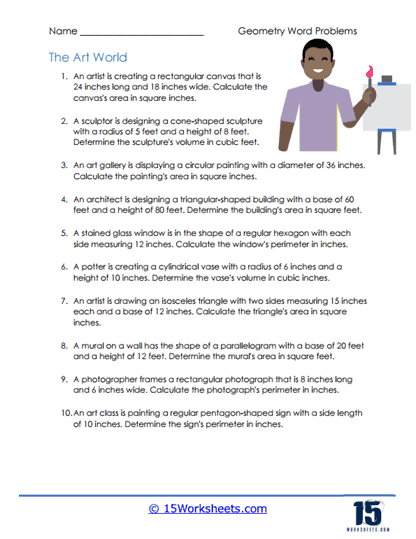The Art World

Worksheet Description
This worksheet is a collection of geometry word problems set in the context of the art world. It features tasks that require students to calculate the area of canvases, the volume of sculptures, the area of paintings, and the dimensions of architectural designs. Students must apply geometric principles to solve problems related to creating and displaying art, such as determining the size of a stained glass window or the perimeter of a photograph.
The worksheet aims to teach students how to apply geometric formulas to calculate areas, volumes, and perimeters within creative and artistic scenarios. It helps to reinforce the students’ understanding of shapes like rectangles, cones, cylinders, and triangles in the real-world context of art and design. This educational tool also seeks to enhance students’ problem-solving skills and encourage an appreciation for the mathematics involved in the creation and presentation of art. By integrating math with art, the worksheet makes learning geometry more engaging and relevant to students interested in the arts.
Example Problems
1. An artist is creating a rectangular canvas that is 24 inches long and 18 inches wide. Calculate the canvas’s area in square inches.
2. A sculptor is designing a cone-shaped sculpture with a radius of 5 feet and a height of 8 feet. Determine the sculpture’s volume in cubic feet.
3. An art gallery is displaying a circular painting with a diameter of 36 inches. Calculate the painting’s area in square inches.
4. An architect is designing a triangular-shaped building with a base of 60 feet and a height of 80 feet. Determine the building’s area in square feet.
5. A stained glass window is in the shape of a regular hexagon with each side measuring 12 inches. Calculate the window’s perimeter in inches.
6. A potter is creating a cylindrical vase with a radius of 6 inches and a height of 10 inches. Determine the vase’s volume in cubic inches.
7. An artist is drawing an isosceles triangle with two sides measuring 15 inches each and a base of 12 inches. Calculate the triangle’s area in square inches.
